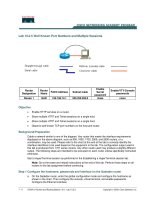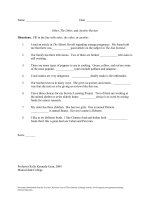Numbers and Operations Review
Bạn đang xem bản rút gọn của tài liệu. Xem và tải ngay bản đầy đủ của tài liệu tại đây (446.05 KB, 32 trang )
Real Numbers
All numbers on the SAT are real numbers. Real numbers include the following sets:
■
Whole numbers are also known as counting numbers.
0,1,2,3,4,5,6,...
■
Integers are positive and negative whole numbers and the number zero.
. . . –3, –2, –1, 0, 1, 2, 3 . . .
■
Rational numbers are all numbers that can be written as fractions, terminating decimals, and repeating
decimals. Rational numbers include integers.
ᎏ
3
4
ᎏᎏ
2
1
ᎏ
0.25 0.38658 0.6
ෆ
6
ෆ
6
ෆ
■
Irrational numbers are numbers that cannot be expressed as terminating or repeating decimals.
π ͙2
ෆ
1.6066951524 . . .
CHAPTER
Numbers and
Operations
Review
This chapter reviews key concepts of numbers and operations that you
need to know for the SAT. Throughout the chapter are sample ques-
tions in the style of SAT questions. Each sample SAT question is fol-
lowed by an explanation of the correct answer.
5
37
Practice Question
The number –16 belongs in which of the following sets of numbers?
a. rational numbers only
b. whole numbers and integers
c. whole numbers, integers, and rational numbers
d. integers and rational numbers
e. integers only
Answer
d. –16 is an integer because it is a negative whole number. It is also a rational number because it can be
written as a fraction. All integers are also rational numbers. It is not a whole number because negative
numbers are not whole numbers.
Comparison Symbols
The following table shows the various comparison symbols used on the SAT.
SYMBOL MEANING EXAMPLE
= is equal to 3 = 3
≠ is not equal to 7 ≠ 6
> is greater than 5 > 4
≥ is greater than or equal to x ≥ 2 (x can be 2 or any number greater than 2)
< is less than 1 < 2
≤ is less than or equal to x ≤ 8 (x can be 8 or any number less than 8)
Practice Question
If a > 37, which of the following is a possible value of a?
a. –43
b. –37
c. 35
d. 37
e. 41
Answer
e. a > 37 means that a is greater than 37. Only 41 is greater than 37.
–
NUMBERS AND OPERATIONS REVIEW
–
38
Symbols of Multiplication
A factor is a number that is multiplied. A product is the result of multiplication.
7 ϫ 8 ϭ 56. 7 and 8 are factors. 56 is the product.
You can represent multiplication in the following ways:
■
A multiplication sign or a dot between factors indicates multiplication:
7 ϫ 8 ϭ 56 7 • 8 ϭ 56
■
Parentheses around a factor indicate multiplication:
(7)8 ϭ 56 7(8) ϭ 56 (7)(8) ϭ 56
■
Multiplication is also indicated when a number is placed next to a variable:
7a ϭ 7 ϫ a
Practice Question
If n ϭ (8 – 5), what is the value of 6n?
a. 2
b. 3
c. 6
d. 9
e. 18
Answer
e. 6n means 6 ϫ n, so 6n ϭ 6 ϫ (8 Ϫ 5) ϭ 6 ϫ 3 ϭ 18.
Like Terms
A variable is a letter that represents an unknown number. Variables are used in equations, formulas, and math-
ematical rules.
A number placed next to a variable is the coefficient of the variable:
9d 9 is the coefficient to the variable d.
12xy 12 is the coefficient to both variables, x and y.
If two or more terms contain exactly the same variables, they are considered like terms:
Ϫ4x,7x, 24x, and 156x are all like terms.
Ϫ8ab,10ab, 45ab, and 217ab are all like terms.
Variables with different exponents are not like terms. For example, 5x
3
y and 2xy
3
are not like terms. In the
first term, the x is cubed, and in the second term, it is the y that is cubed.
–
NUMBERS AND OPERATIONS REVIEW
–
39
You can combine like terms by grouping like terms together using mathematical operations:
3x ϩ 9x ϭ 12x 17a Ϫ 6a ϭ 11a
Practice Question
4x
2
y ϩ 5y ϩ 7xy ϩ 8x ϩ 9xy ϩ 6y ϩ 3xy
2
Which of the following is equal to the expression above?
a. 4x
2
y ϩ 3xy
2
ϩ 16xy ϩ 8x ϩ 11y
b. 7x
2
y ϩ 16xy ϩ 8x ϩ 11y
c. 7x
2
y
2
ϩ 16xy ϩ 8x ϩ 11y
d. 4x
2
y ϩ 3xy
2
ϩ 35xy
e. 23x
4
y
4
ϩ 8x ϩ 11y
Answer
a. Only like terms can be combined in an expression. 7xy and 9xy are like terms because they share the
same variables. They combine to 16xy.5y and 6y are also like terms. They combine to 11y.4x
2
y and
3xy
2
are not like terms because their variables have different exponents. In one term, the x is squared,
and in the other, it’s not. Also, in one term, the y is squared and in the other it’s not. Variables must
have the exact same exponents to be considered like terms.
Properties of Addition and Multiplication
■
Commutative Property of Addition. When using addition, the order of the addends does not affect the
sum:
a ϩ b ϭ b ϩ a 7 ϩ 3 ϭ 3 ϩ 7
■
Commutative Property of Multiplication. When using multiplication, the order of the factors does not
affect the product:
a ϫ b ϭ b ϫ a 6 ϫ 4 ϭ 4 ϫ 6
■
Associative Property of Addition. When adding three or more addends, the grouping of the addends does
not affect the sum.
a ϩ (b ϩ c) ϭ (a ϩ b) ϩ c 4 ϩ (5 ϩ 6) ϭ (4 ϩ 5) ϩ 6
■
Associative Property of Multiplication. When multiplying three or more factors, the grouping of the fac-
tors does not affect the product.
5(ab) ϭ (5a)b (7 ϫ 8) ϫ 9 ϭ 7 ϫ (8 ϫ 9)
■
Distributive Property. When multiplying a sum (or a difference) by a third number, you can multiply each
of the first two numbers by the third number and then add (or subtract) the products.
7(a ϩ b) ϭ 7a ϩ 7b 9(a Ϫ b) ϭ 9a Ϫ 9b
3(4 ϩ 5) ϭ 12 ϩ 15 2(3 Ϫ 4) ϭ 6 Ϫ 8
–
NUMBERS AND OPERATIONS REVIEW
–
40
Practice Question
Which equation illustrates the commutative property of multiplication?
a. 7(
ᎏ
8
9
ᎏ
ϩ
ᎏ
1
3
0
ᎏ
) ϭ (7 ϫ
ᎏ
8
9
ᎏ
) ϩ (7 ϫ
ᎏ
1
3
0
ᎏ
)
b. (4.5 ϫ 0.32) ϫ 9 ϭ 9 ϫ (4.5 ϫ 0.32)
c. 12(0.65 ϫ 9.3) ϭ (12 ϫ 0.65) ϫ (12 ϫ 9.3)
d. (9.04 ϫ 1.7) ϫ 2.2 ϭ 9.04 ϫ (1.7 ϫ 2.2)
e. 5 ϫ (
ᎏ
3
7
ᎏ
ϫ
ᎏ
4
9
ᎏ
) ϭ (5 ϫ
ᎏ
3
7
ᎏ
) ϫ
ᎏ
4
9
ᎏ
Answer
b. Answer choices a and c show the distributive property. Answer choices d and e show the associative
property. Answer choice b is correct because it represents that you can change the order of the terms
you are multiplying without affecting the product.
Order of Operations
You must follow a specific order when calculating multiple operations:
Parentheses: First, perform all operations within parentheses.
Exponents: Next evaluate exponents.
Multiply/Divide: Then work from left to right in your multiplication and division.
Add/Subtract: Last, work from left to right in your addition and subtraction.
You can remember the correct order using the acronym PEMDAS or the mnemonic Please Excuse My Dear
Aunt Sally.
Example
8 ϩ 4 ϫ (3 ϩ 1)
2
ϭ 8 ϩ 4 ϫ (4)
2
Parentheses
ϭ 8 ϩ 4 ϫ 16 Exponents
ϭ 8 ϩ 64 Multiplication (and Division)
ϭ 72 Addition (and Subtraction)
Practice Question
3 ϫ (49 Ϫ 16) ϩ 5 ϫ (2 ϩ 3
2
) Ϫ (6 Ϫ 4)
2
What is the value of the expression above?
a. 146
b. 150
c. 164
d. 220
e. 259
–
NUMBERS AND OPERATIONS REVIEW
–
41
Answer
b. Following the order of operations, the expression should be simplified as follows:
3 ϫ (49 Ϫ 16) ϩ 5 ϫ 3 (2 ϩ 3
2
) Ϫ (6 Ϫ 4)
2
3 ϫ (33) ϩ 5 ϫ (2 ϩ 9) Ϫ (2)
2
3 ϫ (33) ϩ 5 ϫ (11) Ϫ 4
[3 ϫ (33)] ϩ [5 ϫ (11)] Ϫ 4
99 ϩ 55 Ϫ 4
ϭ 150
Powers and Roots
Exponents
An exponent tells you how many times a number, the base, is a factor in the product.
3
5
ϭ 3 ϫ 3 ϫ 3 ϫ 3 ϫ 3 ϭ 243 3 is the base. 5 is the exponent.
Exponents can also be used with variables. You can substitute for the variables when values are provided.
b
n
The “b” represents a number that will be a factor to itself “n” times.
If b ϭ 4 and n ϭ 3, then b
n
ϭ 4
3
ϭ 4 ϫ 4 ϫ 4 ϭ 64.
Practice Question
Which of the following is equivalent to 7
8
?
a. 7 ϫ 7 ϫ 7 ϫ 7 ϫ 7 ϫ 7
b. 7 ϫ 7 ϫ 7 ϫ 7 ϫ 7 ϫ 7 ϫ 7
c. 8 ϫ 8 ϫ 8 ϫ 8 ϫ 8 ϫ 8 ϫ 8
d. 7 ϫ 7 ϫ 7 ϫ 7 ϫ 7 ϫ 7 ϫ 7 ϫ 7
e. 7 ϫ 8 ϫ 7 ϫ 8
Answer
d. 7 is the base. 8 is the exponent. Therefore, 7 is multiplied 8 times.
Laws of Exponents
■
Any base to the zero power equals 1.
(12xy)
0
ϭ 180
0
ϭ 1 8,345,832
0
ϭ 1
■
When multiplying identical bases, keep the same base and add the exponents:
b
m
ϫ b
n
ϭ b
m ϩ n
–
NUMBERS AND OPERATIONS REVIEW
–
42
Examples
9
5
ϫ 9
6
ϭ 9
5 ϩ 6
ϭ 9
11
a
2
ϫ a
3
ϫ a
5
ϭ a
2 ϩ 3 ϩ 5
ϭ a
10
■
When dividing identical bases, keep the same base and subtract the exponents:
b
m
Ϭ b
n
ϭ b
m Ϫ n
ᎏ
b
b
m
n
ᎏ
ϭ b
m Ϫ n
Examples
6
5
Ϭ 6
3
ϭ 6
5 Ϫ 3
ϭ 6
2
ᎏ
a
a
9
4
ᎏ
ϭ a
9 Ϫ 4
ϭ a
5
■
If an exponent appears outside of parentheses, multiply any exponents inside the parentheses by the expo-
nent outside the parentheses.
(b
m
)
n
ϭ b
m ϫ n
Examples
(4
3
)
8
ϭ 4
3 ϫ 8
ϭ 4
24
(j
4
ϫ k
2
)
3
ϭ j
4 ϫ 3
ϫ k
2 ϫ 3
ϭ j
12
ϫ k
6
Practice Question
Which of the following is equivalent to 6
12
?
a. (6
6
)
6
b. 6
2
ϩ 6
5
ϩ 6
5
c. 6
3
ϫ 6
2
ϫ 6
7
d.
ᎏ
1
3
8
3
15
ᎏ
e.
ᎏ
6
6
4
3
ᎏ
Answer
c. Answer choice a is incorrect because (6
6
)
6
ϭ 6
36
. Answer choice b is incorrect because exponents don’t
combine in addition problems. Answer choice d is incorrect because
ᎏ
b
b
m
n
ᎏ
ϭ b
m Ϫ n
applies only when the
base in the numerator and denominator are the same. Answer choice e is incorrect because you must
subtract the exponents in a division problem, not multiply them. Answer choice c is correct: 6
3
ϫ 6
2
ϫ
6
7
ϭ 6
3 ϩ 2 ϩ 7
ϭ 6
12
.
Squares and Square Roots
The square of a number is the product of a number and itself. For example, the number 25 is the square of the
number 5 because 5 ϫ 5 ϭ 25. The square of a number is represented by the number raised to a power of 2:
a
2
ϭ a ϫ a 5
2
ϭ 5 ϫ 5 ϭ 25
The square root of a number is one of the equal factors whose product is the square. For example, 5 is the
square root of the number 25 because 5 ϫ 5 ϭ 25. The symbol for square root is Ί. This symbol is called the rad-
ical. The number inside of the radical is called the radicand.
–
NUMBERS AND OPERATIONS REVIEW
–
43
͙36
ෆ
ϭ 6 because 6
2
ϭ 36 36 is the square of 6, so 6 is the square root of 36.
Practice Question
Which of the following is equivalent to ͙196
ෆ
?
a. 13
b. 14
c. 15
d. 16
e. 17
Answer
b. ͙196
ෆ
ϭ 14 because 14 ϫ 14 ϭ 196.
Perfect Squares
The square root of a number might not be a whole number. For example, there is not a whole number that can
be multiplied by itself to equal 8. ͙8
ෆ
ϭ 2.8284271 ....
A whole number is a perfect square if its square root is also a whole number:
1 is a perfect square because ͙1
ෆ
ϭ 1
4 is a perfect square because ͙4
ෆ
ϭ 2
9 is a perfect square because ͙9
ෆ
ϭ 3
16 is a perfect square because ͙16
ෆ
ϭ 4
25 is a perfect square because ͙25
ෆ
ϭ 5
36 is a perfect square because ͙36
ෆ
ϭ 6
49 is a perfect square because ͙49
ෆ
ϭ 7
Practice Question
Which of the following is a perfect square?
a. 72
b. 78
c. 80
d. 81
e. 88
Answer
d. Answer choices a, b, c, and e are incorrect because they are not perfect squares. The square root of a
perfect square is a whole number; ͙72
ෆ
≈ 8.485; ͙78
ෆ
≈ 8.832; ͙80
ෆ
≈ 8.944; ͙88
ෆ
≈ 9.381; 81 is a per-
fect square because ͙81
ෆ
ϭ 9.
–
NUMBERS AND OPERATIONS REVIEW
–
44
Properties of Square Root Radicals
The product of the square roots of two numbers is the same as the square root of their product.
͙a
ෆ
ϫ ͙b
ෆ
ϭ ͙a ϫ b
ෆ
͙7
ෆ
ϫ ͙3
ෆ
ϭ ͙7 ϫ 3
ෆ
ϭ ͙21
ෆ
■
The quotient of the square roots of two numbers is the square root of the quotient of the two numbers.
ϭ
Ί
ᎏ
a
b
ᎏ
,where b ≠ 0 ϭ
Ί
ᎏ
2
8
4
ᎏ
ϭ ͙3
ෆ
■
The square of a square root radical is the radicand.
(͙N
ෆ
)
2
ϭ N (͙4
ෆ
)
2
ϭ ͙4
ෆ
ϫ ͙4
ෆ
ϭ ͙16
ෆ
ϭ 4
■
When adding or subtracting radicals with the same radicand, add or subtract only the coefficients. Keep the
radicand the same.
a͙b
ෆ
ϩ c͙b
ෆ
ϭ (a ϩ c)͙b
ෆ
4͙7
ෆ
ϩ 6͙7
ෆ
ϭ (4 ϩ 6)͙7
ෆ
ϭ 10͙7
ෆ
■
You cannot combine radicals with different radicands using addition or subtraction.
͙a
ෆ
ϩ ͙b
ෆ
≠ ͙a ϩ b
ෆ
͙2
ෆ
ϩ ͙3
ෆ
≠ ͙5
ෆ
■
To simplify a square root radical, write the radicand as the product of two factors, with one number being
the largest perfect square factor. Then write the radical over each factor and simplify.
͙8
ෆ
ϭ ͙4
ෆ
ϫ ͙2
ෆ
ϭ 2 ϫ ͙2
ෆ
ϭ 2͙2
ෆ
͙27
ෆ
ϭ ͙9
ෆ
ϫ ͙3
ෆ
ϭ 3 ϫ ͙3
ෆ
ϭ 3͙3
ෆ
Practice Question
Which of the following is equivalent to 2͙6
ෆ
?
a. 2͙3
ෆ
ϫ ͙3
ෆ
b. ͙24
ෆ
c.
d. 2͙4
ෆ
ϩ 2͙2
ෆ
e. ͙72
ෆ
Answer
b. Answer choice a is incorrect because 2͙3
ෆ
ϫ ͙3
ෆ
ϭ 2͙9
ෆ
. Answer choice c is incorrect because
ϭ 2͙3
ෆ
. Answer choice d is incorrect because you cannot combine radicals with different radi-
cands using addition or subtraction. Answer choice e is incorrect because ͙72
ෆ
ϭ ͙2 ϫ 36
ෆ
ϭ 6͙2
ෆ
.
Answer choice b is correct because ͙24
ෆ
ϭ ͙6 ϫ 4
ෆ
ϭ 2͙6
ෆ
.
2͙9
ෆ
ᎏ
͙3
ෆ
2͙9
ෆ
ᎏ
͙3
ෆ
͙24
ෆ
ᎏ
͙8
ෆ
͙a
ෆ
ᎏ
͙b
ෆ
–
NUMBERS AND OPERATIONS REVIEW
–
45
Negative Exponents
Negative exponents are the opposite of positive exponents. Therefore, because positive exponents tell you how many
of the base to multiply together, negative exponents tell you how many of the base to divide.
a
Ϫn
ϭ
ᎏ
a
1
n
ᎏ
3
Ϫ2
ϭ
ᎏ
3
1
2
ᎏ
ϭ
ᎏ
3 ϫ
1
3
ᎏ
ϭ
ᎏ
1
9
ᎏ
Ϫ5
Ϫ3
ϭϪ
ᎏ
5
1
3
ᎏ
ϭϪ
ᎏ
5 ϫ
1
5 ϫ 5
ᎏ
ϭϪ
ᎏ
1
1
25
ᎏ
Practice Question
Which of the following is equivalent to Ϫ6
Ϫ4
?
a. Ϫ1,296
b. Ϫ
ᎏ
1,2
6
96
ᎏ
c. Ϫ
ᎏ
1,2
1
96
ᎏ
d.
ᎏ
1,2
1
96
ᎏ
e. 1,296
Answer
c. Ϫ6
Ϫ4
ϭϪ
ᎏ
6
1
4
ᎏ
ϭϪ
ᎏ
6 ϫ 6 ϫ
1
6 ϫ 6
ᎏ
ϭϪ
ᎏ
1,2
1
96
ᎏ
Rational Exponents
Rational numbers are numbers that can be written as fractions (and decimals and repeating decimals). Similarly,
numbers raised to rational exponents are numbers raised to fractional powers:
4
ᎏ
1
2
ᎏ
25
ᎏ
1
2
ᎏ
8
ᎏ
1
3
ᎏ
3
ᎏ
2
3
ᎏ
For a number with a fractional exponent, the numerator of the exponent tells you the power to raise the num-
ber to, and the denominator of the exponent tells you the root you take.
4
ᎏ
1
2
ᎏ
ϭ ͙4
1
ෆ
ϭ ͙4
ෆ
ϭ 2
The numerator is 1, so raise 4 to a power of 1. The denominator is 2, so take the square root.
25
ᎏ
1
2
ᎏ
ϭ ͙25
1
ෆ
ϭ ͙25
ෆ
ϭ 5
The numerator is 1, so raise 25 to a power of 1. The denominator is 2, so take the square root.
8
ᎏ
1
3
ᎏ
ϭ ͙
3
8
1
ෆ
ϭ ͙
3
8
ෆ
ϭ 2
–
NUMBERS AND OPERATIONS REVIEW
–
46
The numerator is 1, so raise 8 to a power of 1. The denominator is 3, so take the cube root.
3
ᎏ
2
3
ᎏ
ϭ ͙
3
3
2
ෆ
ϭ ͙
3
9
ෆ
The numerator is 2, so raise 3 to a power of 2. The denominator is 3, so take the cube root.
Practice Question
Which of the following is equivalent to 8
ᎏ
2
3
ᎏ
?
a. ͙
3
4
ෆ
b. ͙
3
8
ෆ
c. ͙
3
16
ෆ
d. ͙
3
64
ෆ
e. ͙512
ෆ
Answer
d. In the exponent of 8
ᎏ
2
3
ᎏ
, the numerator is 2, so raise 8 to a power of 2. The denominator is 3, so take the
cube root; ͙
3
8
2
ෆ
ϭ ͙
3
64.
ෆ
Divisibility and Factors
Like multiplication, division can be represented in different ways. In the following examples, 3 is the divisor and
12 is the dividend. The result, 4, is the quotient.
12 Ϭ 3 ϭ 43ͤ12
ෆ
ϭ 4
ᎏ
1
3
2
ᎏ
ϭ 4
Practice Question
In which of the following equations is the divisor 15?
a.
ᎏ
1
5
5
ᎏ
ϭ 3
b.
ᎏ
6
1
0
5
ᎏ
ϭ 4
c. 15 Ϭ 3 ϭ 5
d. 45 Ϭ 3 ϭ 15
e. 10 ͤ15
ෆ
0
ෆ
ϭ 15
Answer
b. The divisor is the number that divides into the dividend to find the quotient. In answer choices a and c,
15 is the dividend. In answer choices d and e, 15 is the quotient. Only in answer choice b is 15 the divisor.
–
NUMBERS AND OPERATIONS REVIEW
–
47
Odd and Even Numbers
An even number is a number that can be divided by the number 2 to result in a whole number. Even numbers
have a 2, 4, 6, 8, or 0 in the ones place.
2 34 86 1,018 6,987,120
Consecutive even numbers differ by two:
2, 4, 6, 8, 10, 12, 14 . . .
An odd number cannot be divided evenly by the number 2 to result in a whole number. Odd numbers have
a 1, 3, 5, 7, or 9 in the ones place.
1 13 95 2,827 7,820,289
Consecutive odd numbers differ by two:
1, 3, 5, 7, 9, 11, 13 . . .
Even and odd numbers behave consistently when added or multiplied:
even ϩ even ϭ even and even ϫ even ϭ even
odd ϩ odd ϭ even and odd ϫ odd ϭ odd
odd ϩ even ϭ odd and even ϫ odd ϭ even
Practice Question
Which of the following situations must result in an odd number?
a. even number ϩ even number
b. odd number ϫ odd number
c. odd number ϩ 1
d. odd number ϩ odd number
e.
ᎏ
even n
2
umber
ᎏ
Answer
b. a, c, and d definitely yield even numbers; e could yield either an even or an odd number. The product of
two odd numbers (b) is an odd number.
Dividing by Zero
Dividing by zero is impossible. Therefore, the denominator of a fraction can never be zero. Remember this fact
when working with fractions.
Example
ᎏ
n Ϫ
5
4
ᎏ
We know that n ≠ 4 because the denominator cannot be 0.
–
NUMBERS AND OPERATIONS REVIEW
–
48









